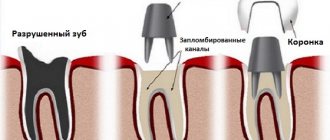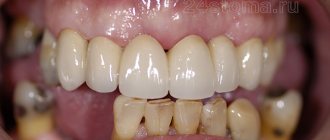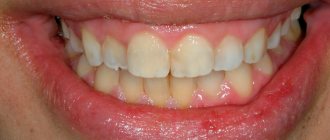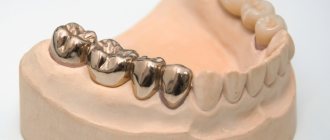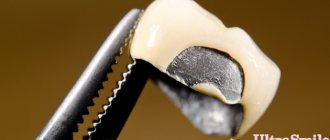A crown is the name in dentistry for a prosthesis that is placed on a tooth, on an implanted implant, or included in the structure of a dental bridge. With the help of dental crowns, you can restore severely damaged or lost teeth, the restoration of which must be carried out urgently and for this you must contact a dentist.
How the crown will be installed, whether it hurts to put a crown on a tooth - we will answer all these questions in detail in our article.
When is it necessary to put a crown on a tooth: indications for restoring teeth with a crown
The need to place a crown on a tooth may arise in the following situations:
- The tooth is severely damaged by caries. If the natural crown of a tooth is damaged by more than 50% by caries, then it would be more correct to put a crown on the tooth rather than restore it with a filling. Large fillings do not withstand the chewing load well and may fall out or break, and the tooth may break along with the filling. If the root of the tooth is damaged, then it will have to be removed. By placing a crown on a decayed tooth, you have the opportunity to save it;
- The tooth is destroyed as a result of trauma. If the roots of a tooth were not affected by injury, it is possible to restore the tooth - it will be enough to put a crown on it;
- You can also put a crown on a tooth for aesthetic restoration: for example, if a tooth is chipped or its enamel has changed color, becoming gray or yellow, and this defect cannot be eliminated by classic whitening.
Doctors recommend placing temporary crowns to preserve teeth for patients with periodontitis. In this case, crowns prevent teeth from becoming loose and falling out.
In your case, do you need to put a crown on your tooth or is it possible to use another restoration method? The doctors of our dental clinic in Moscow, “Firadent,” can help you find the answer to this question. To make an appointment with our specialists, you just need to dial our dental clinic’s phone number!
I need to put a crown on a tooth: is the treatment painful?
Statistics show that most people, knowing that they need to put a crown on a tooth, still postpone their treatment for fear of visiting the dentist and the pain that supposedly cannot be avoided with dental prosthetics. Does it really hurt to put a crown on a tooth? Let's look at this issue together.
So is it painful to put a crown on a tooth or not? The most painful stage in the process of installing a crown on a tooth will be the preparation, during which the teeth are treated for caries, depulped (if necessary), and also ground down to the thickness of the future crown. All these procedures are not performed without anesthesia, as they can cause quite severe pain to the person.
Before you begin to treat and prepare the tooth for placing a crown on it, the doctor will definitely perform an anesthesia procedure using a local anesthetic. The type and amount of the drug are selected individually for each patient. The use of anesthesia makes the process of preparing the tooth for crown installation painless.
If the patient experiences a literally panicky fear of dentists, in our dental clinic “Firadent” he may be offered dental treatment in his sleep[/anchor], under sedation. Sedation should not be confused with general anesthesia; it is a light medicated sleep in which the patient will remain during treatment. Sedation allows you to relieve the patient not only from pain when preparing teeth for prosthetics, but also from psychological discomfort and stress! Moreover, after sedation there are no negative side effects, which are not uncommon after general anesthesia.
You can read all the details on dental treatment during sleep in a separate article on our website, which is devoted to sedation, or find out during a consultation with the doctors of our clinic - “Firadent”.
Initial examination and diagnosis
The decision that a crown needs to be placed on a tooth is made by an orthopedic dentist after examining the patient’s oral cavity and teeth, as well as performing a number of diagnostic measures. Based on the data obtained, the orthopedist will develop a treatment plan, which may include not only the installation procedure itself, but also a number of additional measures:
- Professional oral hygiene, which allows you to clean your teeth from plaque and tartar;
- Removal of severely damaged teeth that cannot be properly treated and restored with a filling;
- Treatment of caries and any other diseases of the teeth and gums diagnosed during examination;
- Tooth removal, treatment and filling of canals.
Note that depulping a tooth before placing a crown on it is not always done. The depulpation procedure involves removing the dental nerve, after which the tooth becomes more fragile and vulnerable to external factors. If a tooth has more than one root and is in good condition, doctors prefer not to remove the dental nerve and put a crown on a living tooth.
When drawing up a treatment plan, the question of what kind of crown will be placed on the tooth is also decided. Modern dental crowns are made from different materials and there is always the opportunity to choose the version of the prosthesis that will most suit the patient in terms of aesthetics, price and durability.
The drawn up treatment plan is agreed with the patient and after agreement the treatment process begins. The first step is to prepare the tooth for the installation of a crown.
What is preparation or grinding of enamel: a complete list of indications for this procedure
Article navigation
- What is preparation
- What preparation is needed before turning?
- Types of turning
- Peculiarities of turning for different types of prostheses
- Types of ledges when fixing crowns
- Features of the procedure in children
- Will it hurt when turning?
- What to do if there is pain after turning
- Is preparation always necessary?
- How much will the turning cost?
Question to a specialist
To restore “problematic” or missing teeth, we go to an orthopedic dentist who offers various prosthetic options. However, the installation of a veneer, crown, removable dentures or bridge is almost always preceded by dental grinding - and the very mention of it immediately frightens patients. What kind of procedure is this, in what situations is it used, will it hurt, what are the features of the preparation and how the process works in patients of different ages - all this is discussed in today’s material.
Preparing to install a dental crown
Preparing for a dental crown may include the following procedures:
- Professional teeth cleaning. Removing tartar and plaque from the surfaces of teeth will help you accurately select the color of the future crown, as well as identify primary caries and other diseases that are important to cure before placing a crown on the tooth.
- Treatment of caries, pulpitis, periodontitis, and gum inflammation. You can’t put a crown on sick teeth!
- Treatment of the tooth on which a crown will be placed. During this process, the doctor will drill out the tooth and remove all tissue affected by caries. If necessary, tooth depulpation is carried out, as well as treatment and filling of dental canals.
IMPORTANT: Dental canal treatment must be of high quality! If during the treatment of the canals the doctor makes a mistake, does not remove all the tissues affected by inflammation, or fills the canals incorrectly, the tooth may begin to hurt already under the crown, and then it will have to be removed and treated again! In our dental clinic “Firadent” in Moscow, treatment of tooth canals is carried out under a microscope with an optical device, which allows the doctor not to act at random, but to accurately see the length and internal space of the dental canals, and therefore carry out the procedure with impeccable quality.
After filling the canals, the tooth is restored with a filling and the next stage in prosthetics begins - turning the tooth under a crown.
Medical Internet conferences
Basic principles of tooth preparation for metal-ceramic crowns.
In the technology of manufacturing fixed structures, the most critical link is the preparation of the supporting teeth, since the process itself is irreversible, unlike other stages, and making gross errors is unacceptable. Therefore, I believe that geometrically correct preparation of the supporting teeth, as well as careful processing of hard tissues in the area of the edges of the future structure, is a very important factor in ensuring the durability of the structure and its biological compatibility with surrounding tissues.
In general, when preparing abutment teeth, it is necessary to create a retention form of the stump, as well as the proper interocclusal space necessary to accommodate an aesthetically satisfying and load-resistant structure. In this case, it is desirable to avoid excessive grinding of hard tissues and trauma to the marginal periodontium. In some cases, a larger volume of grinding of hard tissues and a subgingival location of the preparation border are possible, justified by aesthetic requirements or to increase retention.
Types of ledges
Professor Martignoni offers a choice of three types of ledges
- Shoulder (covered with ceramics and metal)
- Shoulder with bevel (overlaid with metal)
- Rounded ledge with bevel (shamfer with bevel) (overlaid with metal)
The bevel of the edge of the ledge is necessary in order to achieve a tighter fit of the crown to the tooth. The angular shoulder (50 degrees), which Kuwata proposed, according to Professor Martignoni, must be covered with metal, otherwise it will not be possible to create an accurate outer contour of the crown.
The preparation scheme proposed by Martignoni is as follows.
On the vestibular surface there is a shoulder, on other surfaces there is a shoulder or a rounded ledge with a bevel. The width of the ledge is on average 1.2 mm; on proximal surfaces the width can be reduced to 0.8 mm.
Domenico Massironi suggests creating a ledge in the form of a modified rounded slope (a long rounded slope). This ledge is universal and suitable for any type of crown. The practitioner can control tissue reduction by using half the diameter of the diamond bur to prepare the preparation and by keeping the center of the bur as close to the final preparation line as possible. The angle of the ledge is approximately 60 degrees.
Two-plane preparation.
Picture 1
The theory of two-plane preparation was developed and described in detail by Kuwata, a famous Japanese dental technician. According to his theory, the vestibular surface of all teeth and the palatal (lingual) surface of molars and premolars has 3 planes:
- Cervical (which corresponds to the direction of the root plane)
- The main one (which coincides with the plane of the gum of the alveolar process)
- The plane of the cutting edge (in incisors and canines) or tubercle (in premolars and molars).
When preparing for a crown, it is necessary to take into account 2 planes: the main one and the cutting edge. The cervical plane will be important when creating a crown; ideally, the contour of the crown at the margin should coincide with the cervical plane and the direction of the root. Overcontouring of the crown will lead to chronic inflammation of the gums. Three-plane preparation is performed when processing the vestibular surface of the tooth for veneer.
Advantages of two-plane preparation.
- Sufficient space is created for the manufacture of an aesthetic metal-ceramic crown. This is especially important in the area of the cutting edge of the incisors and canines.
- Tooth tissue is preserved in the area of the middle third of the stump. Excessive tooth preparation is avoided.
- A more retentional shape of the stump is created due to less taper in the lower and middle third, that is, the so-called “retention zone” of the stump is not lost.
Conclusion
Planning the preparation of abutment teeth should be based on the following principles:
- maximum preservation of dental tissues performance of two-plane preparation
- providing conditions for retention of the future structure, creating a minimum angle of occlusal convergence
- compliance of the shape and surface of the prepared tooth with the requirements of a specific restoration manufacturing technology (casting, CAD/CAM milling);
- integrity of marginal periodontal tissues,
- dividing the preparation into 2 stages allows you to correct errors made during primary processing, avoid exposing the final preparation line in individuals with a thin periodontal biotype, and makes it possible to make an individual mini or full tray to obtain a one-stage impression.
Grinding a tooth for a crown
Before placing a crown on a tooth, the tooth must be ground to the thickness of the future prosthesis. This procedure in professional dentistry is called “preparation”. The enamel of the tooth is ground down with a drill and during the treatment the doctor will give the tooth a shape that will allow the crown to be placed firmly and tightly.
IMPORTANT: Grinding of live teeth can be quite painful, so local anesthesia must be administered before performing this procedure. If the tooth was depulped before grinding, local anesthesia may not be used, the procedure will not cause pain.
When preparing teeth, a layer of tissue is removed from the tooth before placing a crown. The thickness of the layer will depend on how thick the crown will be. A minimal layer of tissue is removed from the teeth for cast crowns; a significant layer of tissue must be removed from the tooth if it is decided to install ceramic or metal-ceramic crowns. On average, during the grinding process, about 2.5 mm of tissue is removed from a tooth on each side.
As a result of tooth preparation, a core base (stump) is obtained, on which the doctor will place a crown.
Main types of tooth preparation
In modern dental practice, five main methods of tooth preparation are used:
- tunnel;
- laser;
- ultrasonic;
- chemical;
- air-abrasive.
Tunnel preparation
For tunnel turning of abutment teeth, turbine units are used, equipped with speed regulators, as well as metal or diamond tips.
Advantages of the tunnel view
The main advantage of this technique is the ability to control the thickness of the removed layer of dental tissue.
Disadvantages of the tunnel view
The disadvantages of tunnel grinding of teeth include:
- severe overheating of the enamel;
- increased risk of injury to the soft tissues of the mouth if the technique of performing the procedure is violated;
- a high probability of cracks and microscopic chips appearing on hard dental tissues when using worn out or low-quality instruments.
Laser preparation
For laser preparation, pulsed lasers are used to heat the water contained in the hard dental tissues and destroy the integrity of the enamel and dentin. Pieces of sanded fabric are cooled and removed using a special air-water mixture.
Advantages of the laser type
The advantages of laser tooth preparation include:
- high turning speed;
- safety (no equipment elements rotating at high speed);
- absence of noise from the operation of laser equipment;
- low heating temperature of the treated tissues;
- no cracks or chips on the edges of the pin.
Ultrasonic preparation
With ultrasonic preparation, the grinding of teeth is carried out due to high-frequency vibration of the dental instrument under the influence of ultrasound.
Advantages of Ultrasonic View
The main advantages of this method are:
- no negative effect of ultrasonic waves on pulp tissue;
- release of a small amount of thermal energy that is not capable of causing significant overheating of dentin and enamel;
- painlessness;
- no chips or cracks on the pin stacks.
Air abrasive preparation
When using air-abrasive tooth preparation, instead of a drill with a rotating drill, an abrasive-air mixture is used, supplied to the desired area under high pressure. When abrasive powder gets on enamel or dentin, tissue destruction occurs.
Advantages of the air-abrasive type
The advantages of this turning method are:
- absence of tissue overheating and excessive vibration;
- high speed of the procedure and its relative simplicity;
- maintaining the maximum volume of dental tissue;
- painlessness of the performed manipulations.
Chemical preparation
The chemical preparation method of teeth involves softening enamel and dentin using acids and other active chemicals.
Advantages of the chemical type
The advantages of this technique include:
- absence of microcracks and chips on the treated surface;
- painlessness;
- absence of thermal damage to dental tissues.
Disadvantages of the chemical type
The only disadvantage of chemical preparation is the long duration of the procedure.
Making crowns
Crowns are made from an impression that is taken from the prepared teeth. To obtain this impression, the orthodontist will use a special plastic mass. Based on the impression taken, the laboratory will first make a plaster model of the prosthesis, and then a crown, which will be placed on the tooth.
Modern dental crowns are made from different materials: metal, ceramic, metal-ceramic and zirconium. The timing of the production of the prosthesis will depend on what kind of crown it is decided to place on the tooth. Crowns made of ceramics and metal-ceramics take the longest to produce. So that a person does not have to walk without a tooth during the entire time of making the crowns, a temporary plastic prosthesis is put on the tooth.
IMPORTANT: Temporary plastic crowns help hide a defect in the dentition; a person will not have to be embarrassed by the absence of a tooth and experience stress for this reason. Also, temporary dentures help protect a ground and therefore weakened tooth from the negative effects of environmental factors and bacteria.
Varieties of porcelain designs
Dental porcelain is an excellent material that provides ample opportunities for aesthetic restoration. Several types of structures are made from it:
· Veneers. These are thin plates designed to hide minor defects in tooth enamel. They cover only the front surface of the tooth. Porcelain, composite or zirconium dioxide can be used in their manufacturing process.
· Tabs. These are microprostheses made in a dental laboratory. They help solve more serious dental problems with teeth and are used, for example, in cases of severe decay of the crown or the presence of a large carious cavity.
· Crowns. The most versatile design that allows you to achieve a “Hollywood” smile. They are installed on the front teeth during aesthetic restoration.
Try-on, temporary and permanent fixation of the crown
Before placing a crown on a tooth, it must be tried on. For this purpose, the patient is invited to the clinic. During the fitting, the accuracy of the crown's manufacturing and the tightness of its fit on the stump base are assessed. If the fitting does not reveal manufacturing inaccuracies, the patient does not feel discomfort and is satisfied with the aesthetics of the finished product - a temporary fixation of the crown is performed on the tooth.
What is temporary fixation? This is a kind of “test drive” of the crown. With a crown placed on a temporary basis, the patient will walk for a certain period of time (usually up to 4 weeks). If during this time no defects or inaccuracies are identified in the manufacture of the crowns, the patient comes to the clinic and the crown is placed and fixed with permanent dental cement.
At this point, the crown installation process can be considered complete.
How to place a crown on an implant?
A crown can be placed not only on a tooth, but also on an implant. This allows you to restore lost teeth without grinding down healthy units in the rows. Crowns on implants are durable, aesthetic, and visually indistinguishable from natural teeth.
Before placing a crown on an implant, an artificial root implantation procedure is performed. As soon as the implant takes root, an abutment is placed on it, and then a crown. Putting a crown on an implant will be more expensive than conventional prosthetics, but the price of the service is fully compensated by the impeccable aesthetics and long service life of both the implant and the crown.
Reviews of doctors providing the service - solid crowns
Sincere gratitude to the dentist Mikhail Ivanovich Fedoseev!
Thanks for the impeccable work! Mirkerimov F.S. 08/15/2017 Read full review Mirkerimov F.S.
15.08.2017
Together with my husband, we have been treating our teeth in the dental department of the CELT clinic for more than 10 years. The time has come to place implants, and on the advice of our general practitioner Natalya Olegovna Elizarova, I turned to surgeon Evgeniy Borisovich Antyukhin. Despite his youth, the doctor has extensive experience in… Read full review
Olga
30.05.2017
Crown service life
Patients who plan to get a crown are often interested in its useful lifespan. The service life of a crown placed on a tooth will depend on a number of factors:
- Crown material and technology;
- The patient’s compliance with all doctor’s recommendations for crown care;
- Quality of preparation of teeth for prosthetics.
The last factor is of fundamental importance: if mistakes are made during the preparation and manufacturing of the crown, the crown will not last long, and undesirable complications may arise, due to which the crown will have to be removed and re-installed on the tooth. For these reasons, you need to very carefully choose the clinic where you plan to treat and restore your teeth! Remember that the worst type of saving is saving on your own health!
The crown must be placed in a well-equipped dental clinic, staffed by experienced orthopedic doctors and dental technicians. The clinic must use the most modern technologies for diagnostics, treatment and dental prosthetics; only this approach to the choice of dentistry guarantees high quality treatment!
How much does it cost to put a crown on a tooth?
How much does it cost to put a crown on a tooth? It is difficult to give a definite and precise answer to this question, because the cost of installing a crown may include various additional but necessary procedures. For example, professional teeth cleaning, treatment of caries or pulpitis, treatment and filling of canals.
The cost of installing a crown will be influenced by both the material and the production technology of the prosthesis. The most expensive options are ceramic and zirconium crowns produced using CAD/CAM technology. But such crowns fully pay for their cost due to their high strength, reliability and aesthetics.
Also, the cost of installing a crown will depend on how it will be placed - on an abutment tooth or on an implant.
The best way to find out how much it costs to put a crown on a tooth is to come to an appointment with orthopedic doctors at our dental clinic in Moscow - “Firadent”. Experienced specialists of our dentistry will conduct an examination and diagnosis and draw up a treatment plan, which will indicate the exact price of the service.

